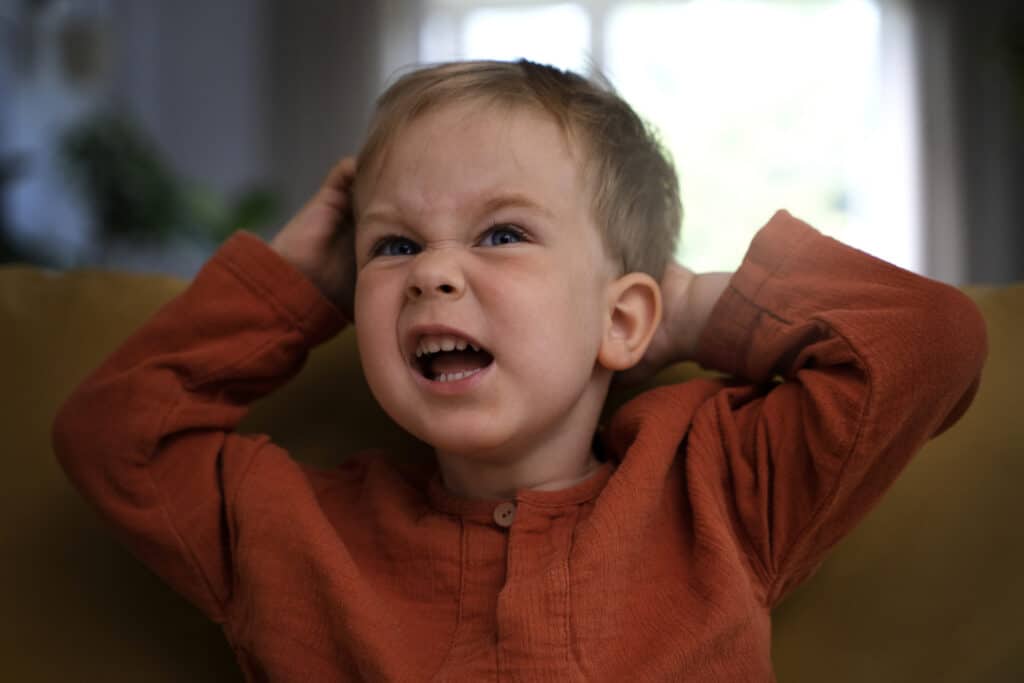Understanding and managing emotions can be difficult for children. Emotional self-regulation strategies for kids can help them navigate this complex area. The techniques presented in this article serve as important tools, guiding children as they learn to understand and manage their feelings.
Teaching these strategies is akin to providing children with essential life skills. These skills increase their resilience, improve their interpersonal relationships, and can also contribute to their academic success. It’s an important part of their personal and social development.
What is Self Regulation?
Self-regulation is akin to maintaining balance, involving a careful mix of self-awareness, self-control, coping mechanisms, and overall well-being, all under the control of the nervous system.
In simple terms, self-regulation is the ability to manage one’s thoughts and feelings. Self-awareness helps a child recognize their emotions and actions. Self-control provides guidance on how to respond appropriately. Coping strategies come into play when a situation needs to be handled differently, and well-being is the desired outcome – a state of calm and contentment.
The nervous system is integral to this process, regulating the child’s emotional and behavioral responses in day-to-day life.
Consider an instance where a child is having a meltdown because they are struggling to tie their shoelaces. Self-regulation empowers the child to manage their reactions. They acknowledge their frustration (self-awareness), opt to calm down (self-control), attempt a new approach or ask for assistance (coping strategy), and in doing so, regain their calm (well-being).
Why is Emotional Regulation so Important for Kids?
Emotional regulation is a crucial element in the structure of child development. It’s a central piece that binds all other aspects together. Emotional regulation serves a vital function, allowing children to manage their emotions effectively.
Now, think of a child’s self-regulation process as a personal compass, guiding them through the emotional landscape of life. It helps them recognize their feelings (north), understand why they’re feeling this way (south), figure out what to do with these feelings (east), and then do it (west). It’s their internal GPS, helping them navigate their emotional world.
Co-regulation, on the other hand, is like a shared journey. It’s the process where an adult helps a child regulate their emotions until they can do it on their own. See it as a parent and child walking hand in hand, the adult pointing out landmarks and paths, helping the child learn the route until they’re ready to travel it alone.
Mastering emotional regulation skills provides children with the necessary tools to handle difficult emotional circumstances. These skills enable them to effectively manage their feelings in tough situations, turning large, overwhelming emotional responses into smaller, manageable reactions. This could be dealing with the disappointment of not getting a toy they want, or managing the fear associated with the first day of school. Emotional regulation supports them in navigating these experiences with confidence.
👉 Is your child hitting themselves? Find out why and learn effective techniques to stop the behavior. Discover more in our article to provide the support your child needs. Click here to learn more!
There is an array of emotional regulation strategies that can help kids. Breathing exercises can help them find stability when strong emotions surface. Visualization techniques can guide them toward calm when they’re feeling distressed. Physical activities can help dissipate accumulated emotional energy. Mindfulness techniques can help them become more aware of their emotional state.
As children grow, emotional control is a consistent support system, helping them navigate emotional ups and downs. It is a journey of self-discovery, resilience, and emotional understanding, a journey that forms them into emotionally intelligent adults, capable of navigating life’s varied experiences.
1. Self-Regulation in Child Development Stages
- 12-18 months: At this stage, children are beginning to learn about their emotions and how to manage them. They rely heavily on caregivers for emotional regulation. For example, a toddler might look to their parent for comfort when they are upset. To support them, caregivers can model calm behavior, provide comfort when needed, and start using simple language to name emotions.
- 2 years: Two-year-olds are becoming more independent and start experimenting with self-regulation. They might try different strategies to soothe themselves, like hugging a favorite stuffed animal. However, they still need a lot of support from adults. Caregivers can continue naming emotions, encourage independent problem-solving, and provide a consistent, comforting routine.
- 3 years: By this age, children are better able to understand their emotions and may begin to use words to express their feelings. They can be taught simple emotional management strategies, such as taking deep breaths when they’re upset. Caregivers can help by praising successful self-regulation, teaching simple coping strategies, and providing opportunities for the child to make decisions.
- Preschoolers (4-5 years): Preschoolers have a more developed understanding of emotions and are better able to use self-regulation strategies. They can engage in activities that require waiting, taking turns, and following rules. The parents can support them by continuing to reinforce coping strategies, encouraging empathy, and discussing feelings regularly.
- Elementary School (6-11 years): School-age children can understand complex emotions and can use multiple ways to self-regulate. They can also think about their emotions and reflect on their actions. Caregivers can help by teaching advanced coping strategies (like positive self-talk), discussing moral issues to encourage empathy, and providing opportunities for independent decision-making.
- Adolescents (12-18 years): Adolescents have a mature understanding of emotions, but their emotional regulation abilities may be challenged by the hormonal changes of puberty. They require guidance to manage stress, peer pressure, and complex emotional situations. Caregivers can support them by promoting open communication about emotions, teaching stress management techniques, and fostering a supportive and understanding environment.
2. How to Recognize Emotional Dysregulation in Children

Emotional dysregulation refers to difficulties in controlling or managing emotional responses. Children with emotional dysregulation may have intense emotional reactions that are difficult to calm down, and they may struggle to return to a balanced state after an emotional episode.
Here are some common signs of emotional dysregulation in children:
- Frequent Tantrums or Meltdowns: While all children have tantrums occasionally, frequent, intense tantrums that are difficult to soothe can be a sign of emotional dysregulation. This includes tantrums that last longer than usual, tantrums that occur multiple times a day, or tantrums that escalate quickly and intensely.
- Excessive Emotional Reactions: Children with emotional dysregulation often have emotional reactions that are disproportionate to the situation. For instance, they might become extremely upset over minor issues, or experience intense anxiety over seemingly small changes or uncertainties.
- Difficulties with Social Skills: Emotional dysregulation can make it hard for children to navigate social situations. They might struggle to maintain friendships, have frequent conflicts with peers, or have difficulty understanding or respecting others’ feelings and boundaries.
- Impulsivity: Children with emotional dysregulation may act impulsively in response to their emotions. This can lead to risky behavior, difficulty following rules, or acting without considering the consequences.
- Physical Symptoms: Emotional dysregulation can also have physical signs, such as frequent complaints of stomachaches or headaches, especially during stressful situations. Some children might also show signs of restlessness, difficulty sleeping, or changes in eating habits.
Emotional dysregulation can significantly impact a child’s well-being and relationships. It can lead to difficulties at school, both academically and socially, and can cause stress within the family. According to the latest research, over time, it can contribute to the development of mental health conditions like anxiety, depression, or behavioral disorders.
👉 Curious to discover more about the top causes of your child’s anger and effective solutions for parents? Dive deeper into our insightful article now and equip yourself with the knowledge to help your child thrive!
Factors Causing Emotional Dysregulation in Children
1. Physical Factors
Genetic Predisposition: Some children may be genetically predisposed to emotional dysregulation due to inherited traits. For instance, a child may be naturally more sensitive, impulsive, or prone to anxiety, which can make it harder to regulate emotions.
Physical Health Conditions: Certain health conditions can impact a child’s ability to regulate their emotions. For example, ADHD, autism spectrum disorders, sensory processing disorders, and other neurodevelopmental disorders often co-occur with emotional dysregulation.
Sleep and Diet: Lack of sleep and poor nutrition can also contribute to emotional dysregulation. Sleep deprivation can make it harder for children to manage their emotions, and a diet lacking essential nutrients can also impact mood and behavior.
2. Emotional Factors
Unresolved Trauma or Grief: Traumatic experiences or unresolved grief can lead to emotional dysregulation. A child might struggle to process their emotions related to the event, leading to emotional outbursts, withdrawal, or other signs of dysregulation.
Insecure Attachment: Insecure attachment can contribute to emotional dysregulation. Children who have not developed a secure attachment with their caregivers might struggle to soothe themselves and manage their emotions effectively.
3. Cognitive Factors
Cognitive factors that can contribute to emotional dysregulation include:
Learning Difficulties: Children with learning difficulties might experience frustration and stress that can lead to emotional dysregulation. They might struggle to express their feelings and needs effectively, leading to emotional outbursts or withdrawal.
Lack of Coping Skills: If a child hasn’t yet learned effective coping strategies for managing stress and strong emotions, they may become overwhelmed and exhibit signs of emotional dysregulation
4. Social & Environmental Factors
Family Environment: A stressful or chaotic family environment can contribute to emotional dysregulation. This might include frequent family conflict, inconsistency in parenting, or exposure to domestic violence.
Peer Relationships: Difficulties with peers can also lead to emotional dysregulation. This includes bullying, social isolation, or struggles with friendship.
School Stress: Academic pressures, high-stakes testing, and other school-related stress can contribute to emotional dysregulation.
All these factors interact in complex ways and can contribute to emotional dysregulation. It’s important to consider all aspects of a child’s life when seeking to understand and support their emotional health.
How to Build Self-Regulation Strategies for Kids: 7 Strategies
- Be a role model for your kid
Children are incredibly perceptive and tend to emulate the behaviors and attitudes of those around them, particularly their parents or caregivers. As such, one of the most effective ways to help your child develop self-regulation skills is to model those behaviors yourself.
Demonstrate how to handle frustration or disappointment in a healthy way, how to take deep breaths when feeling overwhelmed, or how to express feelings using words instead of aggressive actions. For example, if you’re stuck in traffic and feeling frustrated, narrate your feelings and actions: “I’m feeling frustrated right now because we’re stuck in traffic, but I’m going to take some deep breaths and listen to some calming music to help myself feel better.” This not only models self-regulation but also teaches children that it’s okay to express their feelings.
- Create structured routines and predictable environments
Children thrive in environments that provide structure and predictability. Routines help create a sense of order and security, which can reduce anxiety and increase feelings of control—both crucial for developing self-regulation skills.
For instance, establish a daily routine that includes regular meal times, homework time, free play, and bedtime. A visual schedule can be helpful for younger children to understand what comes next. While it’s important to maintain flexibility, a predictable routine helps children know what to expect and gives them the opportunity to practice self-control and responsibility.
- Encourage regulation activities
Certain activities can inherently help children practice self-regulation skills. These include activities that require turn-taking (like board games), following rules (like structured sports or games), or managing frustration (like puzzles or difficult tasks).
For example, playing a board game requires a child to wait their turn, manage emotions when they lose a turn or face a setback, and persist despite challenges—all important self-regulation skills. Similarly, engaging in creative activities like building blocks or drawing requires focus, patience, and the ability to handle mistakes or imperfections.
- Teach the kid relaxation techniques: breathing exercises & mindfulness
Practicing mindfulness and relaxation techniques can significantly improve a child’s ability to self-regulate. These techniques can help children slow down, focus on the present moment, and manage their emotional responses.
One simple technique is deep breathing. Teach your child to take a deep breath in, hold it for a few seconds, then exhale slowly. Another is progressive muscle relaxation, where you tense and then relax each muscle group in the body. Mindfulness can be as simple as focusing on the sensations of eating a piece of fruit or listening to the sounds in a room.
- Use visual charts and timers to manage time & tasks
Visual aids can be incredibly useful tools for teaching self-regulation. They provide a concrete, visual representation of abstract concepts like time, order, and progress, which can be particularly helpful for younger children.
For example, a visual schedule can help children understand the sequence of activities throughout the day, while a timer can help them understand how long they need to focus on a task or wait for their turn. A “feelings chart” with different faces can help children identify and express their emotions, an important aspect of emotional self-regulation.
- Encourage emotional awareness
Helping children understand and articulate their emotions is a crucial part of developing self-regulation skills. Teach your child to name their emotions and express them in appropriate ways.
For instance, if your child is upset because they lost a game, you could say, “It looks like you’re feeling frustrated because you didn’t win. It’s okay to feel frustrated, but it’s not okay to throw the game pieces. Let’s talk about what happened and how we can handle it better next time.” This can be done through conversations, reading books about emotions, or engaging in role-play scenarios.
For example, if a child is upset because they lost a game, you can help them identify their feeling (disappointment), validate it (it’s okay to feel disappointed), and then discuss strategies for managing that emotion (next time, what could we do differently?).
- Build a Trusting Relationship with the Child
A strong, trusting relationship with a caregiver or parent is foundational for a child’s ability to develop self-regulation skills. When children feel safe, understood, and supported, they are more likely to feel comfortable expressing their emotions and needs instead of acting out. Regular, open communication is key to building this trust.
Tip: Spend quality one-on-one time with your child every day, even if it’s just for a few minutes. This shows your child that they’re important to you and that they can trust you with their feelings.
Research shows that these strategies can have a positive impact on young children’s self-regulation skills. For example, a study that looked for the effects of mindfulness on children between 3 to 7 years old showed that kids have the ability to manage better impulsive responses, adapt to new or unexpected situations, and control their attention after they have been engaged frequently in mindfulness activities.
Conclusion

Building self-regulation skills in children asks for patience, understanding, and most importantly, consistency. With empathy, conscious positive interventions, structured routines setting a rhythm to their days, and activities that push their emotional awareness, you’re assembling a solid foundation for your child.
But hey, it’s always more fun to learn together, isn’t it? So why not take this a step further? We’ve got a special event coming up where we delve deeper into these strategies, share experiences, and learn from each other. It’s a fantastic opportunity to further equip yourself on this parenting marathon and contribute to your child’s development.
So, grab your virtual backpacks and join us on this exciting journey! Join our Online Masterclass “How to Calm You And Your Child During Tantrums, Hitting or Yelling Hurtful Things: 4 Steps” and learn how to build your child’s emotional intelligence foundation.
References
Esbjørn, B. H., Bender, P. K., Reinholdt-Dunne, M. L., Munck, L. A., & Ollendick, T. H. (2012). The development of anxiety disorders: considering the contributions of attachment and emotion regulation. Clinical child and family psychology review, 15(2), 129–143. https://doi.org/10.1007/s10567-011-0105-4
Janz, P., Dawe, S., & Wyllie, M. (2019). Mindfulness-based program embedded within the existing curriculum improves executive functioning and behavior in young children: A waitlist controlled trial. Frontiers in Psychology. https://doi.org/10.3389/fpsyg.2019.02052
Mazefsky, C. A., Herrington, J., Siegel, M., Scarpa, A., Maddox, B. B., Scahill, L., & White, S. W. (2013). The role of emotion regulation in autism spectrum disorder. Journal of the American Academy of Child and Adolescent Psychiatry, 52(7), 679–688. https://doi.org/10.1016/j.jaac.2013.05.006
Powers, A., Almli, L., Smith, A., Lori, A., Leveille, J., Ressler, K. J., Jovanovic, T., & Bradley, B. (2016). A genome-wide association study of emotion dysregulation: Evidence for interleukin 2 receptor alpha. Journal of psychiatric research, 83, 195–202. https://doi.org/10.1016/j.jpsychires.2016.09.006










